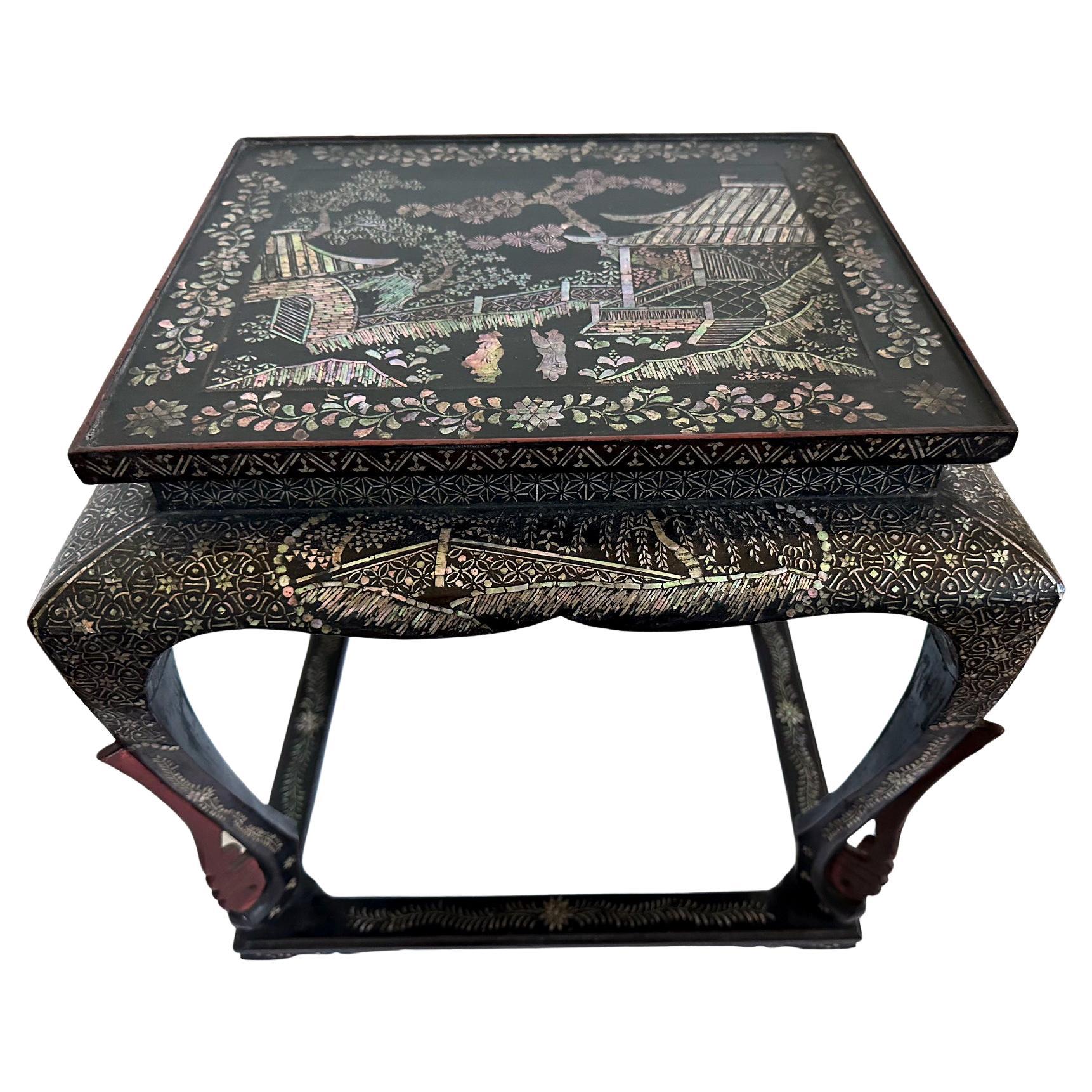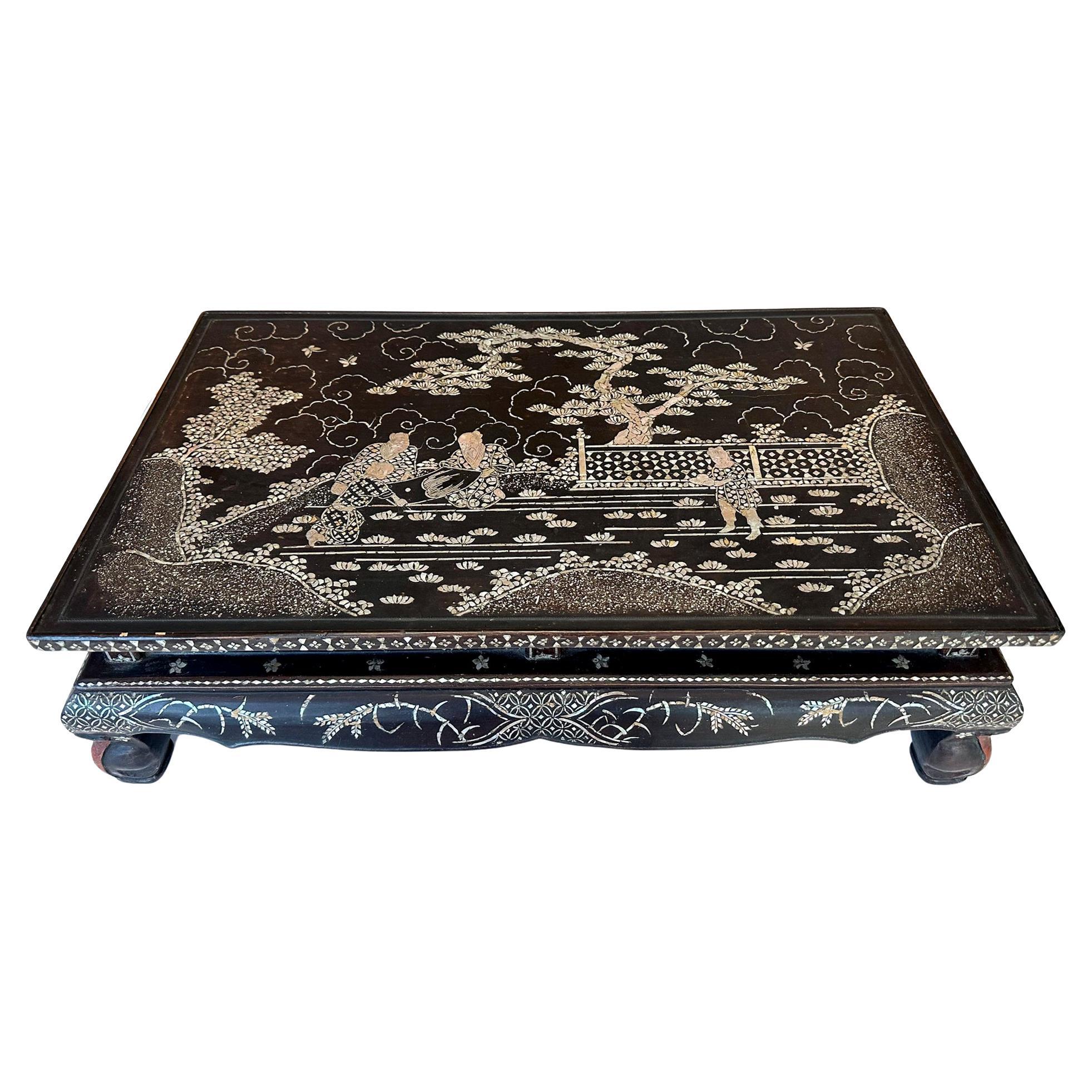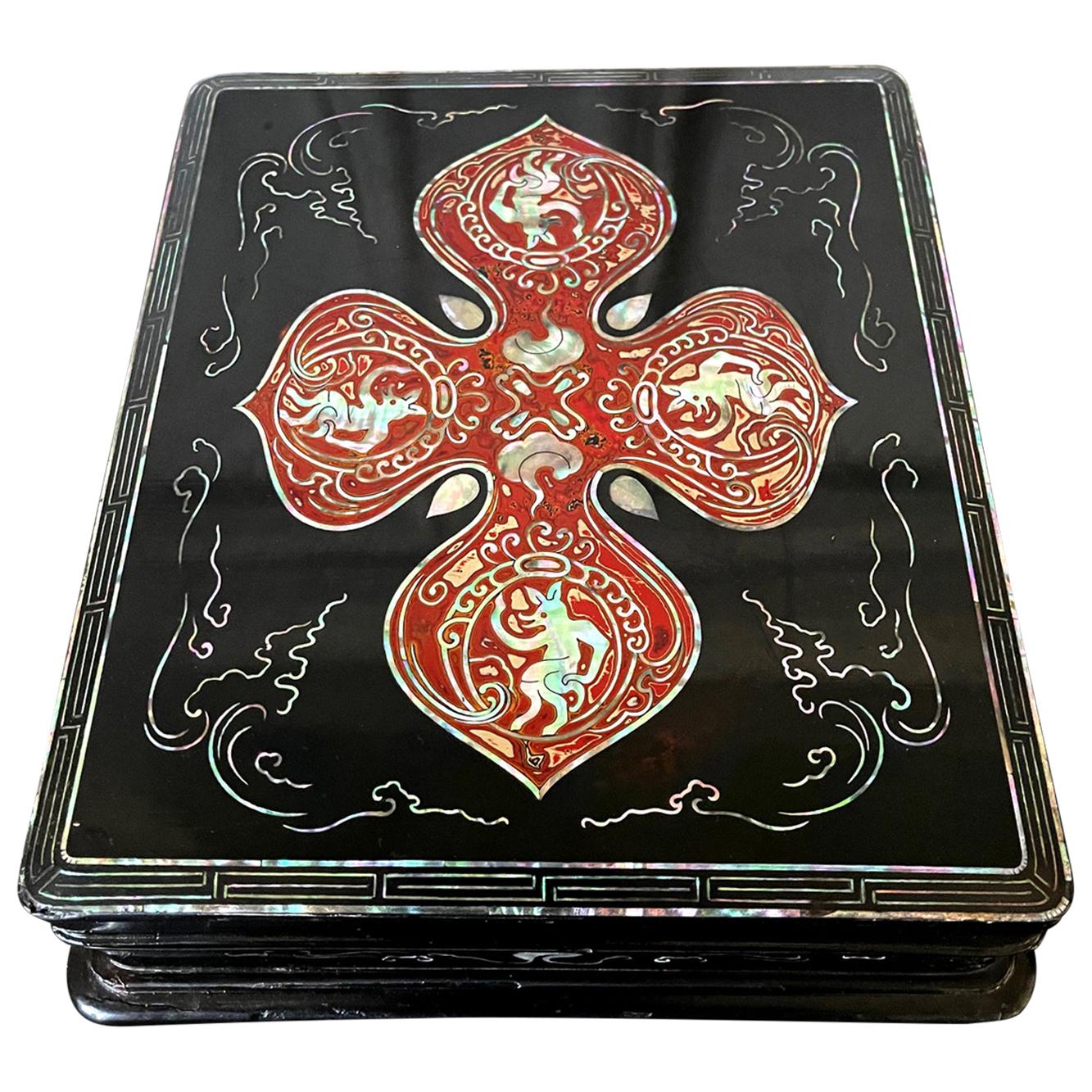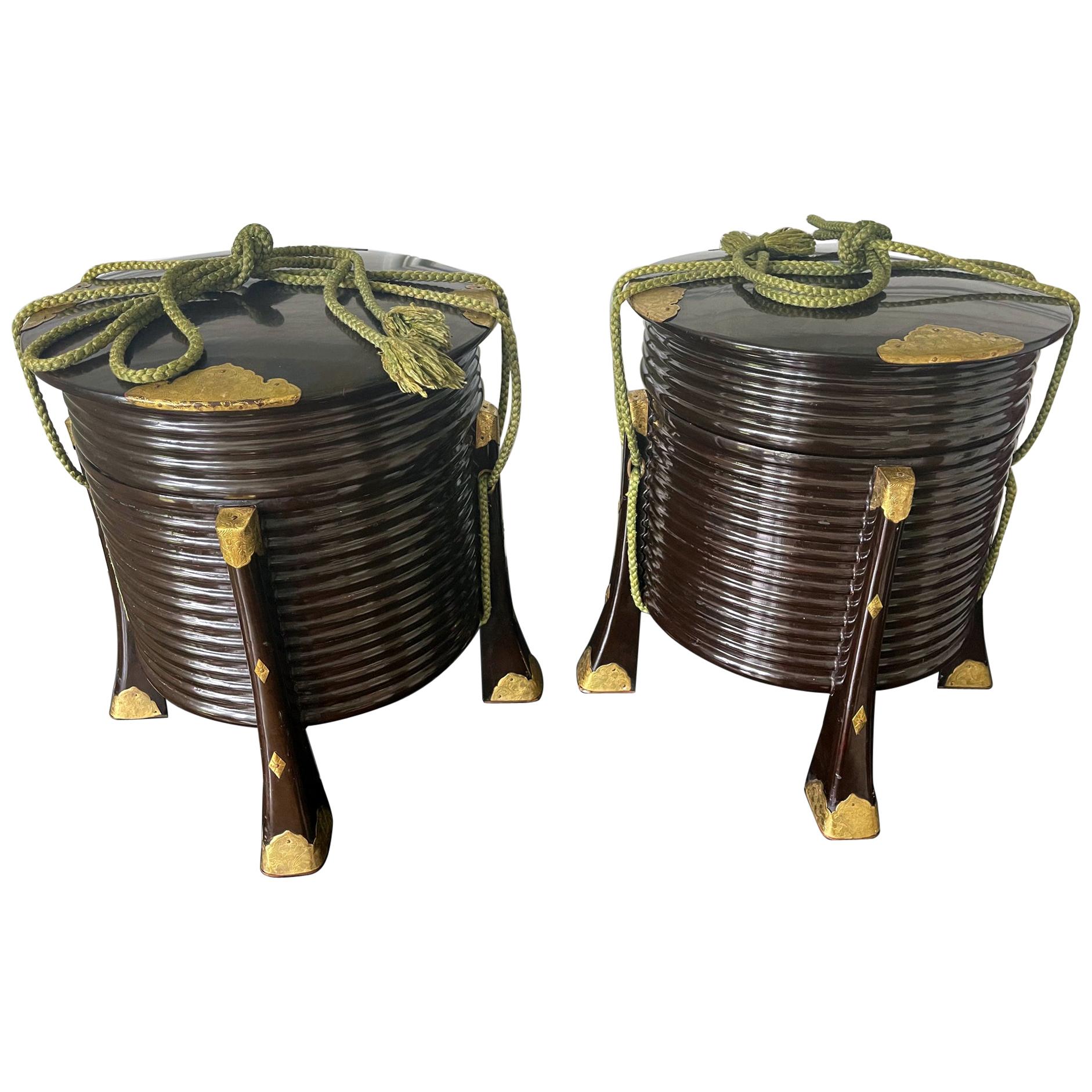Items Similar to Antique Japanese Lacquer and Inlay Box from Ryukyu Island
Want more images or videos?
Request additional images or videos from the seller
1 of 21
Antique Japanese Lacquer and Inlay Box from Ryukyu Island
About the Item
A lacquer presentation box with mother-of-pearl inlays from Japanese Ryukyu Islands circa 17-18th century. The lidded box in rectangular form with rounded corner is a classic example of presentation box made on Ryukyu around the time. At the confluence of aesthetic of China, Korean and Japan, the Ryukyuan lacquerware was distinguished in a unique appeal in its multi-cultural influence and particularly for the extensive and fine workmanship of Raden MOP inlays. Such a box was usually used to present a gift on special occasions. The purpose was subtly revealed by the depicted scene on the front cover. Two men in scholarly attires, each accompanied by an attendant, one apparently holding a gift, are visiting and conversing with each other. The idyllic location is set in a dense pine and bamboo forest in front of a small building. The building on these boxes always appears humble, suggesting a tea house or a rustic studio, which reflects the scholarly character of the men in the picture. The box features slightly scalloped corners and rounded sides slopping down toward the base. Shaped panels with composition of floral scrolling on a pattern ground adorn all four side.
For reference on a similar presentation box, see East Asian Lacquer the Florence and Herbert Irving Collection (Metropolitan Museum of Art) page 357-358.
- Dimensions:Height: 3.25 in (8.26 cm)Width: 15 in (38.1 cm)Depth: 8.125 in (20.64 cm)
- Style:Japonisme (Of the Period)
- Materials and Techniques:
- Place of Origin:
- Period:
- Date of Manufacture:17-18th Century
- Condition:Wear consistent with age and use. Presents beautifully considering its age. Expected surface wear and crackles and minute losses in inlays. Interior clean with spotty lacquer surface unevenness, commonly seen in this type of old lacquerware. Base with contact rubbing. All as shown.
- Seller Location:Atlanta, GA
- Reference Number:1stDibs: LU945025429552
About the Seller
5.0
Platinum Seller
These expertly vetted sellers are 1stDibs' most experienced sellers and are rated highest by our customers.
Established in 2006
1stDibs seller since 2010
479 sales on 1stDibs
Typical response time: <1 hour
- ShippingRetrieving quote...Ships From: Atlanta, GA
- Return PolicyA return for this item may be initiated within 2 days of delivery.
More From This SellerView All
- Antique Japanese Lacquer and Inlay Table from Ryukyu IslandsLocated in Atlanta, GAA small square-form table with lacquer and intricate mother-of-pearl inlay design from Ryukyu Islands kingdom circa 17-18th century. Ryukyuan kingdom was used to be an independent is...Category
Antique 18th Century Japanese Edo Lacquer
MaterialsMother-of-Pearl, Lacquer
- Antique Japanese Lacquer and Inlay Kang Table from Ryukyu IslandLocated in Atlanta, GAA small low table with lacquer and intricate mother-of-pearl inlay design from Ryukyu Islands kingdom circa 17-18th century. Ryukyuan kingdom was used to be an independent island cou...Category
Antique 18th Century Japanese Edo Lacquer
MaterialsMother-of-Pearl, Lacquer
- Unusual Japanese Lacquer Inkstone Box with MOP InlaysLocated in Atlanta, GAA Japanese black lacquer box with mother of pearl inlays circa early 20th century, end of Meiji period. It was likely to be used to store inkstone or other scholarly items. The piece displays several interesting characteristics that appear puzzling initially. First, the form is not typical Japanese, but more Chinese and Korean, with its scalloped base. Second, the decoration of MOP inlays also suggests a Korean and Chinese affiliation, especially with the linear borders and the scrolling cloud patters on the sides of the box. These two observations suggest that the box may be from Ryukyu Island instead of Japanese mainland. Third, strikingly in the center of the cover, a bold quarterly floral pattern outlined with MOP was filled with a striking mottled red lacquer using tsugaru nuri...Category
Early 20th Century Japanese Japonisme Lacquer
MaterialsWood, Lacquer
- Antique Japanese Lacquered Incense Box Kobako Ex-Christie'sLocated in Atlanta, GAAn old Japanese lacquered small box likely used to contain incense powder called Kobako, circa Momoyama to early Edo period (16-17th century). The rectangular form box with a fitted ...Category
Antique 17th Century Japanese Japonisme Lacquer
MaterialsLead
- Pair of Large Antique Japanese Hokai Lacquer BoxesLocated in Atlanta, GAA pair of Japanese lacquered lidded Hokai boxes with chased brass hardware and original ropes. Hokai boxes are traditionally used in Japan as the containers ...Category
Early 20th Century Japanese Japonisme Lacquer
MaterialsWood, Lacquer
- Pair of Large Antique Japanese Hokai Lacquer BoxesLocated in Atlanta, GAA pair of Japanese lacquer lidded Hokai boxes with chased brass hardware and original ropes. Hokai boxes are traditionally used in Japan to store and carry s...Category
Early 20th Century Japanese Japonisme Lacquer
MaterialsWood, Lacquer
You May Also Like
- Japanese Lacquer BoxLocated in New York, NYA Japanese red burgundy, gold and black lacquer box with round corners and silk cloth interior lining, circa early-20th century, 1920s, Japan. Box was desi...Category
Early 20th Century Japanese Decorative Boxes
MaterialsWood, Silk
- Japanese Lacquer Hokai Box, 19th CenturyLocated in Pasadena, CAThis is a good example of a traditional Japanese Hokai shell storage box for the Kai-awase game. This box is well-detailed in chased brass appliques and makie. The box is in overall ...Category
Antique Late 19th Century Japanese Japonisme Lacquer
MaterialsWood, Lacquer
- Antique Japanese Lacquer Stacking Food Box 'Jubako'Located in Hudson, NYWith all-over mother of pearl inlay and mon design of chrysanthemum in gold and black lacquer on top. The chrysanthemum is a national symbol of Japan and the Imperial family.Category
Antique 19th Century Japanese Lacquer
MaterialsGold
- Japanese Lacquered Tebako 'Box'Located in PARIS, FRTebako box with three compartments in golden and nashi-ji lacquer, decorated with golden, red, and kirigane lacquer, golden persimmon tree leaves, among rocks. The compartments are of increasing size from the top. The decoration is in continuity. Persimmon has been cultivated in southern China for more than 2500 years and is believed to have been introduced to Japan in the 8th century. The veneer is a tree with very hard wood, similar to ebony. According to a legend, one specimen survived the atomic bombing of Nagasaki on August 9, 1945, close to the epicenter. It is therefore in Japan a symbol of strength and longevity. It is also the national fruit of the country. It is eaten as a traditional dish during New Year's Day celebrations. Tebako literally means "portable box...Category
Antique 1860s Japanese Lacquer
MaterialsLacquer
- Antique Japanese Dramatically Carved and Lacquered Stack Box on StandLocated in Hudson, NYAntique Japanese dramatically carved and lacquered stack box on stand. Meiji period (1868 - 1912) lacquer stacking box, traditionally used for bringing mochi (rice cake) to celebrati...Category
Antique Late 19th Century Japanese Meiji Lacquer
MaterialsLacquer
- Black and Gold Lacquer Japanese Suzuribako BoxLocated in Stamford, CT19th century Japanese black and gold lacquer Suzuribako box with firefly and plum blossom design.Category
Antique Late 19th Century Japanese Decorative Boxes
MaterialsLacquer





